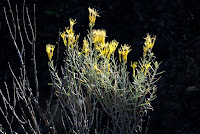Those of us who dwell in the Northwest are somewhat familiar with its volcanic past. Our Cascade mountain range is peppered with active and inactive volcanoes and school children in the area learn about many of them in class and with field trips. Crater Lake (Mazama) in southern Oregon is probably the best known volcanic site, or perhaps Mt. Saint Helens (Loo-wit) in Washington.
 |
| Paulina Lake in the Newberry Caldera |
But you may not know that the largest Cascade range volcano is at Newberry National Volcanic Monument, near Bend, OR. It is so massive, it would cover the entire state of Rhode Island. And it does not look like a cone style peak. Rather, it has become a shield volcano due to repeated eruptions (more than 400,000) over its life. The latest eruption was a mere 1, 300 years ago and experts say it is still an active volcano that could erupt at any time.
 |
| Big Obsidian Flow |
It's a fascinating place to visit, even if you are not a geologist. The various federal agencies who manage the 1,200 square miles of the monument and adjacent lands do an excellent job of making it available and providing interesting educational sites for the curious. We have visited the area many times over the years; in the fall of 2015 we spent a couple of days looking around the Newberry Caldera, which we had not done for about 10 years. The caldera is about 4 by 5 miles in size, with two large lakes sitting in it. The massive "Big Obsidian Flow" is here as well, covering several hundred acres.
 |
| Ponderosa Pine Struggles to Survive in Lava Flow |
The expansive lava flows and the obsidian flows are extremely harsh environments for trees and plants, yet we can see a few of them making a go of it as we walk the lava trails in the monument. Outside the lava, in this high desert land and the surrounding areas of soil, millions of lodgepole and ponderosa pine thrive in the extreme cold winters and very hot, dry summers. The place is a true testament to plant evolution for survival. Read more about these pines at
Northwest Conifers.

In the northern part of the monument, Lava Butte and the visitor center serve as a good location to get your bearings and take in a 360 degree view of the area. There is a working fire lookout as well as a small parking area and a trail to explore the Lava Butte cinder cone. You'll see many square miles of lava that has spewed out of the cinder cones in the area. Several trails allow you to safely enter the lava fields.
As harsh as it is, the lava supports several hardy native species, such as Rabbitbrush (
Ericameria nauseosa), Manzanita, Ponderosa Pine, and the rare Cusick's Monkeyflower (
Mimulus cusickii).
 |
Manzanita and Ponderosa Pines on the south side of the
Lava Butte cinder cone. |
 |
Marsh Forget-Me-Not (Myosotis scorpioides) along the
Deschutes River at Lava Lands |
The monument is named for Dr. John Strong Newberry, an American geologist, physician, and explorer who lived from 1822 to 1892. Oddly, it is unclear if he ever visited Central Oregon during his vast career. But YOU can visit and explore this fascinating area almost any time of year!
 |
| Deschutes River and Lodgepole Pines |



 In the northern part of the monument, Lava Butte and the visitor center serve as a good location to get your bearings and take in a 360 degree view of the area. There is a working fire lookout as well as a small parking area and a trail to explore the Lava Butte cinder cone. You'll see many square miles of lava that has spewed out of the cinder cones in the area. Several trails allow you to safely enter the lava fields.
In the northern part of the monument, Lava Butte and the visitor center serve as a good location to get your bearings and take in a 360 degree view of the area. There is a working fire lookout as well as a small parking area and a trail to explore the Lava Butte cinder cone. You'll see many square miles of lava that has spewed out of the cinder cones in the area. Several trails allow you to safely enter the lava fields.




No comments:
Post a Comment